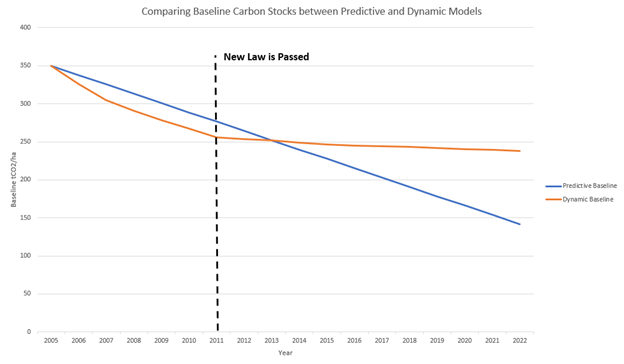
Making the Case for Dynamic Baselines
Baselines are the most important part of a forest carbon project. They quantify additionality and are the primary factor in determining the amount of credits a project is issued over its lifetime. Baselines can be quantified in countless ways. Most avoided deforestation projects use some type of remote sensing algorithm to measure forest canopy loss in the surrounding region some time period prior to the project start year. Improved forest management projects in the United States often depend on regional common practice data obtained from various sources. Some projects include surveys of the local population, historical land records, or a multitude of other methods to determine regional or local land trends.
What the overwhelming majority of projects have in common is that their baselines are both predictive and static. This means baselines are designed using data from the past to predict the future, and they do not change unless verifiers find a flaw or the registry’s methodology requires an update. While this may seem intuitive at first, the accuracy of a static baseline is susceptible to changing land use trends over time. This is where the power of dynamic baselines becomes evident.
Dynamic baselines do not depend on historical data, nor do they try to predict the future. Instead, a dynamic baseline will use real-time data to create regularly updated baselines, typically on a yearly basis as many major data sets are updated annually. This allows the baseline to adjust for gradual changes in land use patterns, or sudden and significant events such as a law change or market development during the life of the project. Paired with a strong nearest neighbor pixel-matching algorithm, this can create powerful data-driven baselines, but this is a topic for another blog post.
To compare the difference between a static baseline and a dynamic one, let’s use a hypothetical example. Let’s say a project uses historical remote sensing data to construct a predictive static baseline and determines the average annual baseline deforestation rate for the project should be 3.5% per year. That rate would then be applied to the project’s crediting each year up until the registry’s methodology requires an update. Verra, for example, requires projects to update their baselines every 10 years.
Alternatively, another project right next door employs a dynamic baseline showing that rate should actually be higher for the first several years of the project. For example, 7% the first year, 6% the second, and so on. Perhaps there was an increase in regional deforestation rates in the years leading up to the project start that a static average deforestation rate would not pick up on. This means the project using the static baseline would be under credited for those years.
Then suddenly, a new law is passed that nearly stops regional deforestation in its tracks. The project using the static baseline will soon become over credited, while the project using the dynamic baseline adjusts to this new reality in real-time and is properly credited to reflect new regional land use trends. To illustrate this example, see the graph below showing the two baselines side by side over time.

This example is not farfetched. Laws, markets, and other factors change land use patterns all the time. In Brazil, for example, deforestation rates in the Amazon rain forest decreased by 34% in the first six months of 2023 following the election of President Luiz Inacio Lula da Silva in 2022, replacing Jair Bolsonaro (Source). Starting in the year 2000, China began restricting and eventually banning commercial logging on state forests throughout the country (Source). Indonesia attempted a similar ban on harvesting in peatlands and primary forests starting in 2011, but the effects of that ban were inconclusive, and it was eventually retracted in 2021 (Source).
In Renoster’s reviews, baselines are the most common cause of over crediting for forest carbon projects. Renoster uses a dynamic baseline for our reviews up until the most recent data is available before switching to a predictive model. We provide a dynamic baseline score in each of our reviews to compare with the project’s baseline over that same time period, and we often find the project’s baselines to be too aggressive. This is not to say Renoster’s baseline models are perfect, far from it, but it is a trend we have noticed and felt it was worth sharing. We strongly believe projects would be better off deploying dynamic baselines moving forward, and we believe the tide is shifting in that direction. Verra, for example, recently released a dynamic baseline methodology for improved forest management projects in the United States starting in 2022 (Source).
We have the technology. Let’s use it.
References:
- China’s Logging Ban in Natural Forests, Forest Trends.




